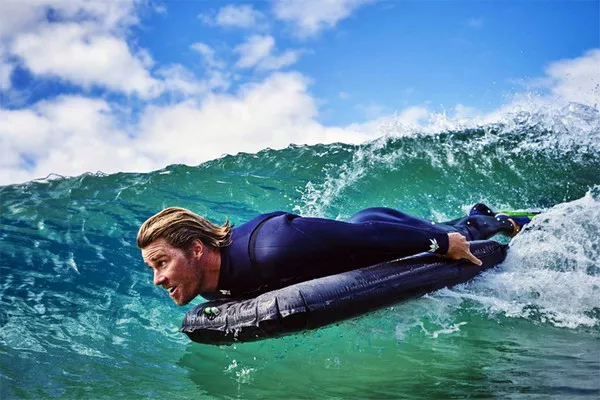In the realm of alternative wave riding, a fascinating and dynamic sport has emerged known as mat surfing. This unique water activity combines elements of surfing, bodyboarding, and even skimboarding, yet remains distinct in its own right. Mat surfing involves the use of specially designed inflatable mats, typically made of canvas or vinyl, which surfers use to catch waves and navigate the ocean. Despite its relatively niche status within the broader surfing community, mat surfing boasts a rich history and a dedicated following of enthusiasts around the globe.
A Brief History
The origins of mat surfing can be traced back to the early 20th century when Duke Kahanamoku, the legendary Hawaiian surfer, used an inflatable air mattress to catch waves in Waikiki. This makeshift approach laid the groundwork for what would later become a more organized and recognized sport. Over time, dedicated individuals refined the design of these mats, experimenting with materials and shapes to optimize performance in the water.
The sport gained momentum particularly in the 1950s and 1960s when surf culture was booming. Mat surfing offered an accessible entry point into wave riding, requiring minimal equipment and offering a playful alternative to traditional surfboards. However, as surfboard technology evolved and the shortboard revolution took hold, mat surfing receded somewhat into the background, cherished primarily by a small cadre of devoted participants.
The Mat and Its Characteristics
What sets mat surfing apart from other wave riding disciplines is the equipment itself—the mat. These mats are typically rectangular or oval-shaped and inflated with air. The materials used are robust enough to withstand the rigors of the ocean environment yet flexible to conform to the contours of the waves. The size of the mat can vary, with some designs accommodating a single rider while others are large enough for tandem surfing or even group sessions.
One of the key advantages of mat surfing is its portability. Deflated, these mats can be rolled up and easily transported, making them ideal for surfers seeking waves in remote or less accessible locations. Additionally, the simplicity of the equipment means lower costs and less maintenance compared to traditional surfboards.
Riding Technique and Challenges
Mat surfing requires a unique set of skills distinct from those used in conventional surfing. Unlike rigid surfboards, mats are buoyant yet pliable, requiring riders to adapt their balance and technique. The rider lies prone on the mat, using hand paddling and body shifts to steer and maneuver. Timing and wave selection are critical, as mats lack fins or other stabilizing features found on surfboards.
One of the most exhilarating aspects of mat surfing is its unpredictability. The mat’s flexible nature allows for creative approaches to wave riding, including spins, slides, and unconventional maneuvers not feasible on standard boards. However, this flexibility also presents challenges, particularly in larger surf conditions where maintaining control demands a keen sense of timing and responsiveness.
Community and Culture
Despite its relative obscurity within mainstream surfing, mat surfing boasts a vibrant and tight-knit community of enthusiasts. Dedicated mat riders can be found in coastal regions around the world, from California to Cornwall, Australia to Japan. Annual gatherings and events celebrate the spirit of mat surfing, showcasing the camaraderie and shared passion among participants.
The culture of mat surfing is characterized by a deep appreciation for the ocean and a commitment to preserving the sport’s heritage. Many mat surfers embrace environmental stewardship, advocating for clean beaches and sustainable practices. Moreover, the inclusive nature of mat surfing welcomes newcomers and fosters mentorship, ensuring that the sport continues to thrive and evolve.
Equipment Evolution and Innovation
In recent years, mat surfing has experienced a resurgence fueled by renewed interest in alternative wave riding experiences. Modern advancements in materials and manufacturing techniques have led to a new generation of high-performance mats. These innovations include improved grip surfaces, enhanced durability, and refined shapes that optimize speed and maneuverability.
Furthermore, the internet and social media have facilitated the sharing of knowledge and experiences within the mat surfing community. Online forums, video tutorials, and equipment reviews have contributed to a broader awareness of the sport, attracting curious surfers seeking fresh challenges.
Conclusion
Mat surfing represents a captivating fusion of tradition and innovation within the surfing world. Rooted in history yet embracing modern technology, this dynamic sport offers a distinctively personal and exhilarating wave riding experience. Whether you’re a seasoned surfer looking to expand your repertoire or a newcomer seeking a novel aquatic adventure, mat surfing promises thrills and camaraderie in equal measure.
As the sport continues to evolve and gain recognition, it’s essential to celebrate its heritage and preserve its core values of community, creativity, and connection to nature. Whether catching gentle rollers close to shore or charging down the face of a powerful wave, mat surfing invites enthusiasts to explore the endless possibilities of wave riding in a truly unique and liberating way.

